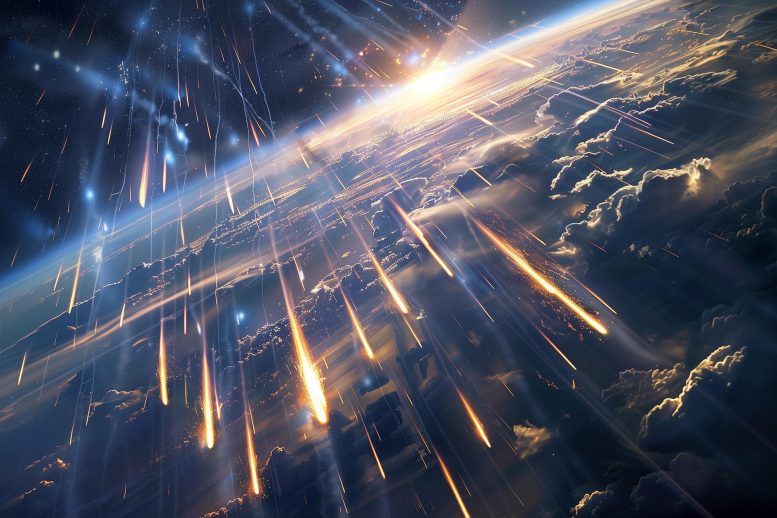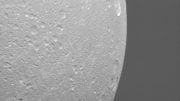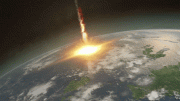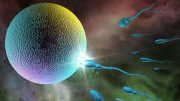
A new study examines how decreased geomagnetic field intensity correlates with an increase in cosmogenic radionuclides like beryllium-10 during the Laschamps excursion, emphasizing its implications for Earth’s protection against space radiation. Credit: SciTechDaily.com
Research indicates a significant increase in cosmogenic radionuclides during the Laschamps excursion, pointing to reduced geomagnetic protection and potential biosphere upheavals.
Earth’s magnetic field cocoons our planet from the onslaught of cosmic radiation streaming through space while also shielding us from charged particles hurled outward by the sun. But the geomagnetic field is not stationary. Not only does magnetic north wobble, straying from true north (a geographically defined location), but occasionally, it flips. During these reversals, north becomes south, south becomes north, and in the process, the intensity of the magnetic field wanes.
Magnetic Field Excursions
But there’s also something called magnetic field excursions, brief periods in which the intensity of the magnetic field wanes and the dipole (or two magnetic poles) that we’re familiar with can disappear, replaced with multiple magnetic poles. The Laschamps excursion that occurred around 41,000 years ago is among the best studied. It features a low magnetic field intensity that implies less protection for Earth’s surface from harmful space rays. Periods of low magnetic field intensity could correlate to major upheavals in the biosphere.
Measuring Cosmic Ray Impact
To see when cosmic rays were heavily bombarding Earth’s surface, scientists can measure cosmogenic radionuclides in cores from both ice and marine sediment. These special isotopes are produced by the interaction between cosmic rays and Earth’s atmosphere; they are born of cosmic rays, hence they are cosmogenic.
Research Findings on Space Climate
Times of lower paleomagnetic field intensity—less shielding—should correlate to higher rates of cosmogenic radionuclide production in the atmosphere. Sanja Panovska, a researcher at GFZ Potsdam, Germany will present her findings about the relationship between paleomagnetic field intensity and cosmogenic nuclides during the Laschamps excursion, with a focus on space climate, next week during the European Geosciences Union (EGU) General Assembly 2024.
Variations in cosmogenic radionuclides like beryllium-10 provide an independent proxy of how Earth’s paleomagnetic intensity changed. Indeed, Panovska found that the average production rate of beryllium-10 during the Laschamps excursion was two times higher than present-day production, implying very low magnetic field intensity and lots of cosmic rays reaching Earth’s atmosphere.
Geomagnetic Reconstructions
To wring more information from both cosmogenic radionuclide and paleomagnetic data, Panovska reconstructed the geomagnetic field using both datasets. Her reconstructions show that during the Laschamps excursion, the magnetosphere shrank when the field dramatically decreased, “thus reducing the shielding of our planet,” she said. “Understanding these extreme events is important for their occurrence in the future, space climate predictions, and assessing the effects on the environment and on the Earth system.”
To learn more about this work, Panovska will give an oral presentation during session EMRP3.3 at EGU 2024 on Friday, 19 April, 14:05-14:15 CEST, Room -2.20









What does this mean for radiometric dating that assumes a constant decay rate?
Suspicious observer on u tube has the low down on upcoming pol shift. The pole don’t necessarily flip keeping the same position just switching poles. They end up in different places, they have guess where they will be next time. What that spells for earth is rather complex and human existence isn’t really figured into it. Will be by chance for the most part. Good chance the atmosphere will not be the same.
Hello I not can commenting sent the is Mobil mader
All the images of the galaxies taken by the James Webb telescope are amazing, but what’s the use? I saw the images of the galaxies 43 years ago and found out that they were never created by God and… they were only discovered and the Big theory Bang, it is very, very far from the reality. What God and… revealed to me is true about existence, and I have a surah in this regard that describes the soul, man, sun, moon, earth, galaxies, and the universe. This surah is called the planets. There are a hundred billion stars in the galaxy, there is never any life that is civilized. Tens of billions of years ago, the earth was separated from a star next to the big arm of the galaxy, and next to the sun, if the earth was next to the sun from the beginning, all oxygen is 17 types of oxygen in the air. It existed and fuel is necessary for life 5:05 am Iran not is me arabic